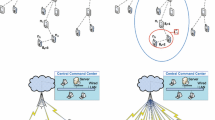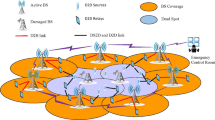Abstract
Wireless industry, driven by manifold increase in data and devices, is attracting the attention of public safety services for critical communications under disaster scenarios and unpredictable events. In this paper, we present a Device-to-Device (D2D)-based communication mechanism that can serve as an additional alternative to the existing critical communication technologies, used in public safety networks. D2D-based low power transmission and energy saving features make it a perfect candidate for vital communication backup, in a case of a network infrastructure failure or a natural disaster. Our proposed mechanism, referred as Survival on Sharing (SoS), utilizes these D2D features to overcome the mobile devices’ power limitation faced during disaster and emergency situations. Our aims are to prolong the battery life and extend the device connectivity in disaster zones. This is achieved by optimizing the amount of valued battery life available in the network. Simulation results show that our proposed mechanism is able to extend devices’ usage duration up to 11 hours and reduce the devices’ outage probability in comparison to the traditional cellular scheme. Battery lifetime gain ranging from 3.6 to 12% is achieved for varying number of users and coverage areas.












Similar content being viewed by others
References
Munich, R. E. (2015). NatCatSERVICE. Natural Catastrophe Review Webinar. https://www.munichre.com/site/mram-mobile/get/documents_E336591247/mram/assetpool.mr_america/PDFs/4_Events/MunichRe_III_NatCatWebinar_071415_pdf.
Doumi, T., Dolan, M. F., Tatesh, S., Casati, A., Tsirtsis, G., Anchan, K., et al. (2013). LTE for public safety networks. IEEE Communications Magazine, 51(2), 106–112.
ETSI. (2015). User requirements specification mission critical broadband communications part 2: Critical communications application. ETSI TR 102 022-2 V1.1.1 2015-01.
Lien, S. Y., Chien, C. C., Tseng, F. M., & Ho, T. C. (2016). 3GPP device-to-device communications for beyond 4G cellular networks. IEEE Communications Magazine, 54(3), 29–35.
Fodor, G., Parkvall, S., Sorrentino, S., Wallentin, P., Lu, Q., & Brahmi, N. (2014). Device-to-device communications for national security and public safety. IEEE Access, 2, 1510–1520.
Zhang, Y., Zhao, C., Hong, L., Yu, J., & Li, S. (2016). Interference alignment with random vector quantisation in device-to-device underlaying cellular networks. IET Communications, 10(10), 1255–1262.
Zhao, N., Yu, F. R., & Sun, H. (2015). Adaptive energy-efficient power allocation in green interference-alignment-based wireless networks. IEEE Transactions on Vehicular Technology, 64(9), 4268–4281.
Zhao, N., Yu, F. R., Jin, M., Yan, Q., & Leung, V. C. (2016). Interference alignment and its applications: A survey, research issues, and challenges. IEEE Communications Surveys and Tutorials, 18(3), 1779–1803.
Paulson, A., & Schwengler, T. (2013). A review of public safety communications, from LMR to voice over LTE (VoLTE). In IEEE 24th international symposium on personal indoor and mobile radio communications (PIMRC) (pp. 3513–3517).
Kumbhar, A., & Guvenc, I. (2015). A comparative study of land mobile radio and LTE-based public safety communications. In IEEE SoutheastCon (pp. 1–8).
Kumbhar, A., Koohifar, F., Guvenc, I., & Mueller, B. (2016). A survey on legacy and emerging technologies for public safety communications. IEEE Communications Surveys and Tutorials.
Chen, X., Guo, D., & Grosspietsch, J. (2013). The public safety broadband network: A novel architecture with mobile base stations. In IEEE international conference on communications (ICC) (pp. 3328–3332).
Merwaday, A., Tuncer, A., Kumbhar, A., & Guvenc, I. (2016). Improved throughput coverage in natural disasters: Unmanned aerial base stations for public-safety communications. IEEE Vehicular Technology Magazine, 11(4), 53–60.
Lin, Y. D., & Hsu, Y. C. (2000). Multihop cellular. A new architecture for wireless communications. In IEEE proceedings of the 19th annual joint conference of the IEEE computer and communications societies (INFOCOM) (Vol. 3, pp. 1273–1282).
Yuksel, M., Guvenc, I., Saad, W., & Kapucu, N. (2016). Pervasive spectrum sharing for public safety communications. IEEE Communications Magazine, 54(3), 22–29.
Hunukumbure, M., Moulsley, T., Oyawoye, A., Vadgama, S., & Wilson, M. (2013). D2D for energy efficient communications in disaster and emergency situations. In International conference on software, telecommunications and computer networks (Soft-COM) (pp. 1–5).
Al-Hourani, A., Kandeepan, S., & Jamalipour, A. (2016). Stochastic geometry study on device-to-device communication as a disaster relief solution. IEEE Transactions on Vehicular Technology, 65(5), 3005–3017.
Prasad, A., Kunz, A., Velev, G., Samdanis, K., & Song, J. (2014). Energy-efficient D2D discovery for proximity services in 3GPP LTE-advanced networks: ProSe discovery mechanisms. IEEE Vehicular Technology Magazine, 9(4), 40–50.
Ta, T., Baras, J. S., & Zhu, C. (2014). Improving smartphone battery life utilizing device-to-device cooperative relays underlaying LTE networks. In IEEE international conference on communications (ICC) (pp. 5263–5268).
Trifunovic, S., Hossmann-Picu, A., & Hossmann, T. (2015). Passing the torch: Role alternation for fair energy usage in D2D group communication. In IEEE international conference on communication systems and networks (COMSNETS) (pp. 1–8).
Jain, R., Chiu, D., & Hawe, W. (1984). A quantitative measure of fairness and discrimination for resource allocation in shared systems. Digital Equipment Corporation. Technical Report DEC-TR-301.
Lee, N., Lin, X., Andrews, J. G., & Heath, R. W. (2015). Power control for D2D underlaid cellular networks: Modeling, algorithms, and analysis. IEEE Journal on Selected Areas in Communications, 33(1), 1–13.
Khan, F. H., Choi, Y. J., & Bahk, S. (2014). Opportunistic mode selection and RB assignment for D2D underlay operation in LTE networks. In IEEE 79th vehicular technology conference (pp. 1–5).
3GPP TS 36.213. (2016). E-UTRA physical layer procedures, V13.0.1. www.3gpp.org.
Karaer, A., Bulakci, O., Redana, S., Raaf, B., & Hamalainen, J. (2009). Uplink performance optimization in relay enhanced LTE-advanced networks. In IEEE international symposium on indoor and mobile radio communications (pp. 360–364).
Huang, Z., Zeng, Z., & Xia, H. (2011). Improving energy efficiency of two-tier OFDMA femtocell networks with distributed power control. Advances in Information Sciences and Service Sciences (AISS), 3(7), 52–61.
Fodor, G., & Reider, N. (2011). A distributed power control scheme for cellular network assisted D2D communications. In IEEE global telecommunications conference (GLOBECOM) (pp. 1–6).
Xu, C., Song, L., & Han, Z. (2014). Resource management for device-to-device underlay communication (pp. 1–79). Berlin: Springer.
de Melo, Y. V., Batista, R. L., Maciel, T. F., e Silva, C. F., da Silva, J. M. B., & Cavalcanti, F. R. (2014). Power control with variable target SINR for D2D communications underlying cellular networks. In VDE proceedings of 20th European wireless conference (pp. 1–6).
PowerTutor [Open Source Application Software]. (2013). http://ziyang.eecs.umich.edu/projects/powertutor/
Trestian, R., Moldovan, A.N., Ormond, O., & Muntean, G.M. (2012). Energy consumption analysis of video streaming to android mobile devices. In IEEE network operations and management symposium (NOMS) (pp. 444–452).
Acknowledgements
This research was supported by Basic Science Research Program through the National Research Foundation of Korea (NRF) funded by the Ministry of Education (NRF−2016R1D1A1B03935633).
Author information
Authors and Affiliations
Corresponding author
Rights and permissions
About this article
Cite this article
Ahmad, H., Agiwal, M., Saxena, N. et al. D2D-based Survival on Sharing for critical communications. Wireless Netw 24, 2283–2295 (2018). https://doi.org/10.1007/s11276-017-1469-2
Published:
Issue Date:
DOI: https://doi.org/10.1007/s11276-017-1469-2




